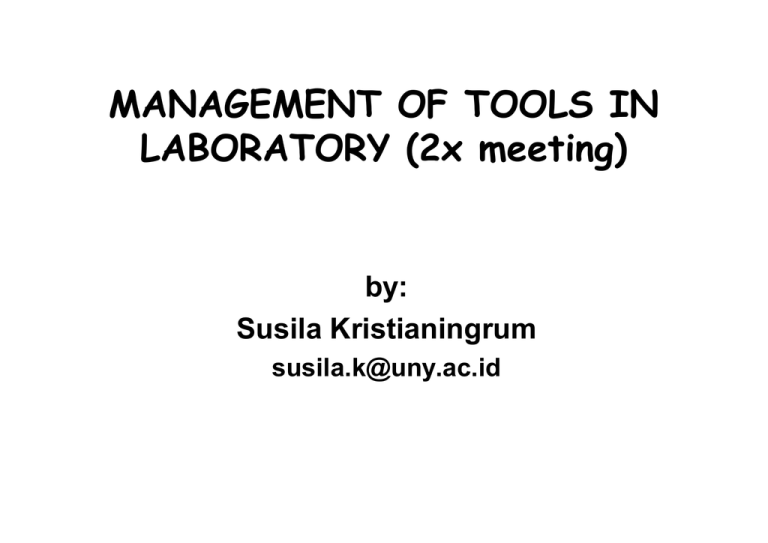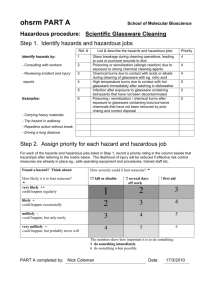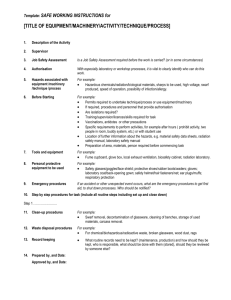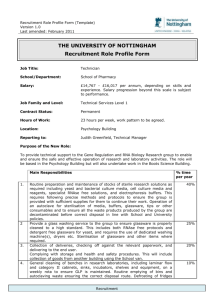MANAGEMENT OF TOOLS IN LABORATORY (2x meeting) by: Susila Kristianingrum
advertisement

MANAGEMENT OF TOOLS IN LABORATORY (2x meeting) by: Susila Kristianingrum susila.k@uny.ac.id MAINTENANCE STORAGE CLEANING INVENTORY MANGEMENT OF TOOLS DRYING Example of Science Laboratory Equipment The technique uses laboratory equipment • • reliable accurate • treated, serviced, maintained, calibrated, to prevent rapid deterioration and guaranteed accuracy Laboratory equipment will be works well 1. Have Been registered (already registered) 2. Ready-made, calibrated with accurate and can work well 3. Available infrastructure that supports (power supply, water, or gas) 4. There are experts / skilled for a special instrument (AAS, UV-VIS, HPLC, GC) 5. There are spare parts (spare parts) 6. There tooling equipment (tools kits) 7. There consumables (material support for specialized equipment such as a solution of reagents) 8. Routine inspection and regular 9. The existence of a continuous care and maintenance. Laboratory Equipment Props education Equipment lab / research Furniture Tool Other equipment Props education (Alat peraga pendidikan) Chart Picture Model Film Slide book Equipment of practicum/ research • Glassware • Instrument • Other equipment Furniture Support equipment laboratory activities: table practicum table demonstration Desk Bench Wardrobe Shelf board Tool The tools used for making or repairing other tools: Screwdriver (obeng) Scissors (gunting) Pliers (catut) Hammer (martil) Miserly (kikir) Saws wood and iron (gergaji kayu dan besi) Etc Measuring tools and specialized tools • • • • • • • • • • • • • pHmeter chromatography Equipment Polarograf OHP Refractometer technical Balance Polarimeter analytical balance Spectrophotometer Dryng oven vacuum pump Centrifuged AAS, etc Support equipment (tools) required for working in a laboratory • Fire extinguishers • P3K box complete with contents • Hygiene equipment • Other tools A variety of laboratory equipment that is tooling support Chemical Laboratory Equipment glass iron wood porcelain plastic rubber electricity optics Chemical Laboratory Equipment 1. 2. 3. 4. 5. Properties The situation (shape) Functions Price usage Glassware • • • • Erlenmeyer Flask distillation flask Round-bottom flask • measuring glass • Beaker glass • watch glasses • • • • • • • funnel glass Burette cooling Liebig glass stirrer test tube bottle weigh etc. The tools of metal tripod stative buret clamp Three finger clamp crucible tongs stative funnel etc. The tools of wood Test tube rack Test tube clamp etc. Setting glassware heavier equipment on the bottom and the lighter in the higher tool size is higher in the back and a low or short in front tool length lying position / lie down tools that do not have a backrest (round-bottom flask) are stored in cardboard boxes. Setting glassware • • • • All equipment is inventoried in the book inventory records Each device is placed in accordance with the kind of tools and size Use of the tool should be recorded in the log book out tools All the tools were kept back finishes used in a closed cupboard Settings tool instrument In a special room with specific requirements For example: GC, UVVIS and FTIR have AC Placed electrodes immersed in the solution The use by people who are experts, appropriate manual tool The damage must be repaired by skilled technicians Safety Equipment • • • • • • • • Hydrant Eye washer Water shower Lab coats should be arm's length Gloves Gogle Mask First Aid Supplies Personal Protective Equipment Eye protection specific to the hazard 23 Personal Protective Equipment Respiratory Protection Requires: training & fittesting Can provide a false sense of security. 24 Care and Maintenance 1. Prevention is better than cure (prevention is better than cure) 2. Reading the fine manual tools 3. Learn the basic principles of equipment, installation method (installation), operation, maintenance methods, problem solving techniques "troubleshooting", and the use of tools (tool kits). Care and Maintenance 1. The problem is usually caused by: neglect, abuse tool 2. The problem is usually caused by a mechanical problem and not an electronic problem 3. In pHmeter caused by the electrodes and batteries, the spectrometer as a current source or a detector, and the microscope due to dirt, mildew, or lights. Tools that use electricity – – – – – – – – Source voltage The tool is turned on Fuse (fuse) unbroken Electricity reaches tool power cable Outlet Arde Fire hazard, shorted, or shock Sample Care and Maintenance Troubleshooting spectrometer: 1. Determining the details of interference 2. Reading the manual tool 3. Check for electrical equipment 4. Observing the table "Troubleshooting in the manual: the radiation source (light) can not be set at 100% radiation reaching the sample, the detector can not be set to zero. In the machine tool – – – – – – – Check engine oil Battery / power source Stability Safety (safety use) Disposal dangers round vibrational Maintenance of Balance Balance is often damaged due to these factors: a. Failure to use b. storage c. The process of equilibrium (at zero or equilibrium f not reached equilibrium there are 2 ways: Small-scale shear load at the front to the right until it reaches equilibrium and mark shows what number of small loads that have shifted it. When used for weighing, then the value / number is later as a deduction. The mass of the load that weighed less number / scale of small loads that have shifted it. Remove the mounting plate portion hanging weights, and go to the bottom using a screwdriver and complete or subtract expenses (such as buckshot, nails, small metal / powder). How to Bring a Microscope • Hold the handle with your right hand and place your left hand to support him • Do not swing, toss, or vibrates when putting a microscope • Do not lift the body of the microscope in the tube, as there will be parts that fall off or if this is done. Maintenance of Microscope Put it in a box to avoid dust Clean dust cover Store in dry place In the cupboard+ lamp (15-20) watt Clean the lenses carefully dg: a soft cloth moistened with xylol reply Source of damage to the equipment / materials due to environmental • • • • • • • Air Water, Acids, Bases, and Other Fluids Heat or temperature Mechanical Beam Fire The nature of the chemical itself A variety of laboratory equipment made of glass A variety of laboratory equipment in the form of assemblies, commonly used in physics laboratories or laboratory techniques Trial process aids such as tweezers (pinset), scissors and a Bunsen burner, mortar What to know before making arrangements equipment • Identifying tools and functions • Identifying the properties of materials • Quality tools including the sophistication and thoroughness • Value / price of the tool • The quality and rarity of these tools • The basic ingredients compiler tools • The shape and size of the tools • The weight / weight equipment Maintenance of Glassware • • • • • • Washing Drying Storage Use stringing tools (merangkai alat) open circuit devices How to remove dirt remnants of substance • • • • Remove as much material Do not throw dirt remnants substances, paper, or solid waste into the sink. Analysis of types of impurities and equipment to be cleaned Eliminate inorganic impurities with dust abrasive powder / soap, water and a brush, if hard with dilute HNO3 How to Clean tools based pollutants A. Organic matter impurities 1. Can be removed using abrasive ash or soap, brush and warm water. 2. The use of acid - a strong acid such as sulfuric acid or chromic sulfuric acid cleaning solution is dangerous 3. Vigreux and spiral coolers, with soapy water soaking, after washing with water and then rinsed with a solvent B. Inorganic matter impurities Eliminate inorganic impurities with ash scouring powder or soap, water, and brush, if hard to dilute HNO3 Such as pipette measuring can be done by soaking in a solution of sulfuric acid C. Fat impurities The equipment washed with hot water (warm) and detergent to remove oil and grease Rinsed with water to remove detergent If stubborn as pipette measuring can be done by soaking in a solution of sulfuric acid chromate (if I had to, because it is dangerous) Drying • • • • Leave it overnight in the lab workbench (drying rack) Beaker and flask placed upside down on drying time Test tube, a small funnel, and so placed on filter paper scrap stored at the bottom of the beaker Glass tool can quickly dried with acetone Drying • Drying burette, pipette, measuring instruments, chromatography columns, is done by storing it upright with the tip upside down. • Drying can quickly use the oven dryer, blow dryer or rinsed with acetone. Glassware storage • Not to be combined with iron or wooden • Equipment with a glass connection (eg separator funnel, burette, and Soxhlet) connections must be removed or covered with vaseline • To open a jammed joint glassware made dg heat the connection with a small fire while playing. • Avoid connection atmospheric alkaline glasses • Glassware should also be stored in the upper rack Efforts to prevent possible damage • Given a dust cover Arranged according to the existing table and layout available Optic equipment arranged in a special place / in the closet, given lamp (15-20) watts Arranged according to the function and characteristics Do not place the equipment is not in place The room temperature • For the subtropical temperatures are suitable (1025 C) • In Indonesia (tropical regions are operating temperature 310C). • Other aspects that contribute to the damage are: Rarely or little used Placements are not suitable / bad (poor of accommodation) Less service (lack of services) Unsuitable environmental Structuring and storage based on: • Determined by the state laboratory facilities, laboratory layout, and the state of equipment / materials. • User interest is determined based on the ease sought and achieved, security storage and retrieval. Various laboratory equipment stored in wardrobes tool • Using the appropriate tool usage instructions. • Maintain cleanliness of equipment • storing tools Kebijakan Keselamatan Lab • Tidak boleh makan, minum, merokok di lab • Beri Label semua wadah bahan kimia • Beri Label “No Food” pd refrigerator • Beri Label “explosion safe” pd refrigerator • Kontrol secara rutin pd APK • dll 50 Control How are the risks controlled? • Engineering controls: – isolation – ventilation --hood • Emergency Plan • Personal Protective Equipment (PPE)/ Alat Pelindung Diri 51 Action and behavior The condition are not safe Less control of the supervisor Recognition Types of lab hazards: chemical toxicity fire / explosion physical hazards biohazards radiation special substances 53 Physical and Ergonomic Hazards • Moving unguarded parts, pinches vacuum pump belts • Broken glassware and sharps, cuts • Pressure apparatus • Vacuum containers • Dewar flasks • High voltage equipment • Computer workstations • Slips, trips & falls 54 Other Hazards in a Chemical Laboratory 55 Asbestos-Containing Materials • Gloves • Lab hoods • Lab benches 56 57 58 59 60 61 Centrifuge Equipment • Uses • Hazards • Control of hazards – – – – Only authorized users can use equipment Users must be trained Assign responsibility to lab tech Include in periodic lab inspections 62 • Rotor • Drive Shaft • Motor 63 varying degrees of protection • Cabinet provides Centrifuge Safety Don’t overload … Check rotor for cracks Keep rotor and centrifuge clean … 64 Set it up right… 65 66 67 Housekeeping 68 69 70 71 Do not use hoods for storage! 72 Don’t block hood air flow. Place large equipment in a hood on 5 cm blocks to allow air flow around and under equipment. 73 Don’t block hallways and exits! 74 Access to emergency equipment is essential. Always check that equipment is not blocked. 75 Food is never allowed in laboratories. 76 What’s Wrong With This Picture? 77 Open-toed shoes are not allowed in laboratories. Employees are not allowed to wear gloves, lab coats or other PPE outside the lab. 78 Don’t Do This… 79 Workstation Design 80 5 point base Workstation Design Rules • Chairs: 5 cm and 110 degree rule - Adequate lumbar support • Neutral wrist position • Elbow 90 degree at “keyboard home row” • Screen below eye level - Copy at same height • Illumination: prevention of glare • Breaks: rest eyes and body 81 DAFTAR PUSTAKA • Anonim. (2012). Perawatan&Perbaikan Alat Lab.Biologi, Fisika, Kimia. Jakarta: Direktorat P2TK Dikmen. • Ensiklopedi Indonesia. (1991).Petunjuk Pemeriksaan Laboratorium Puskesmas , Depkes RI. • Lehman, J.W. (2008). The Student’s Lab. Companion. Laboratory Techniques for Organic Chemistry. New Jersey: Prentice Hall. • Masmei Siallagan. (2011). Cara Pengelolaan & Penyimpanan Peralatan Lab. Kimia yang Baik & Benar. Medan: Chemistry Community. • Moran, L. and Masciangioli, T. (2010). Chemical Laboratory Safety and Security A Guide to Prudent Chemical Management. Washington DC: The National Academies Press. • Regina Tutik P dan Susila Kristianingrum. (2007). Diktat Kuliah Manajemen Laboratorium. Yogyakarta: FMIPA UNY.




